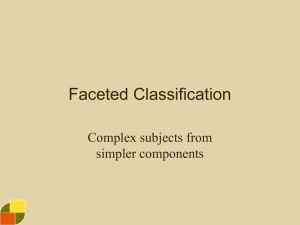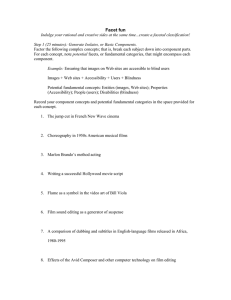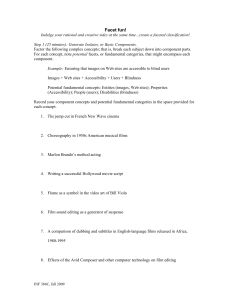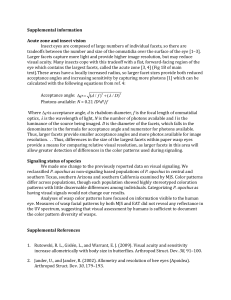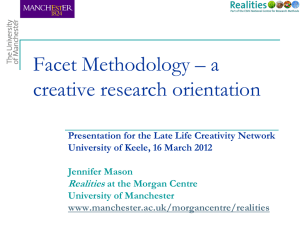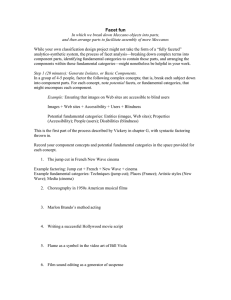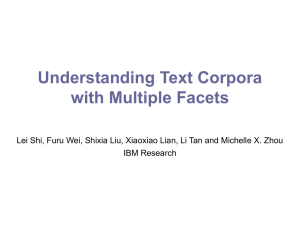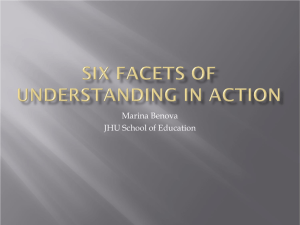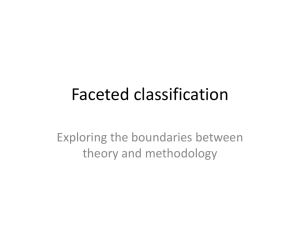Folktales & Films: Facet Analysis in Cultural Heritage
advertisement
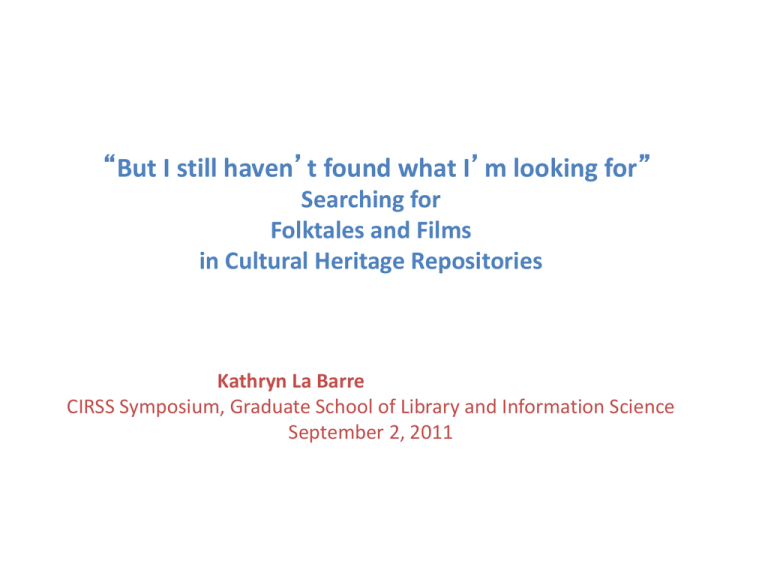
“But I still haven’t found what I’m looking for” Searching for Folktales and Films in Cultural Heritage Repositories Kathryn La Barre CIRSS Symposium, Graduate School of Library and Information Science September 2, 2011 Overview • Recent conversations • Where it all began • Current projects 2 Recent Conversations Returning the (faceted) gaze Les Cahiers du numérique Instantiation A Semantic (Faceted) Web? Facet Theory: Geographically Bounded - or Transcendent? Traditions Vagaries of language Facet Analysis Fundamental Categories Object vs Subject Facets ISKO Spain/UK Geography + Tradition Formal coding SKOS – OWL Ontology building Formal Concept Analysis ISKO C/US Aesthetics Where It All Began: Brian Vickery A structure such as facet may validly represent certain aspects of a field, but only limited aspects. Do we in fact need a much richer set of semantic relationships such as some ontologies are trying to achieve? In short–what is the future of facets? (FA) =Facet Analysis Digital Resources Information Organization FA Information Architecture Knowledge Management LIS Information Retrieval Terms Facet A generic term used to denote any component of a compound subject, (Ranganathan, 1967, p. 88). Groups of terms derived by taking each term and defining it, per genus et differentiam, with respect for its parent class (Vickery, 1960, p. 12). Facet analysis (technique / theoretical framework) Observing the rules of logical division. (Broughton, 2001, p. 67; Mills, 2004, p. 268). One characteristic of division is applied at a time [conceptual analysis] Division steps should be logical and proximate Division should be exhaustive (Mills, 2004, pp. 551). Peeling the Onion In Calvin Mooers’ words, “Facet provides an analytical tool; that is, the idea of facet allows you to peel the onion of an idea.” Brian Vickery. Faceted Classification Schemes. In Susan Artandi (Ed.) Rutgers Series on Systems for the Intellectual Organization of Information. V. 5. New Brunswick, NJ: Graduate School of Library Science at Rutgers University Process • Map – (Context) Examine the domain – (Content) Survey the literature – (Users) Who? Information needs? • Label/ sort – Depth analysis – Begin analysis with a list of “standard categories” (provisional guide) – Result: set of homogeneous mutually exclusive groups (facets) – Formulate every distinctive logical category and possible relation • Cluster /order – into arrays or groups which share a common characteristic Collect exemplars archival sources oral histories What is facet analysis? Analyze instantiations Codify process practice Process? Application? Evidence / Instantiations ARTICULATION Informed application Formalized process Theoretical extension Theory > Practice Practice> Theory Heritage • Universal Decimal Classification – Otlet, La Fontaine -Documentalists – 1904-1907 – scheme published • Bliss Bibiliographic Classification – Henry Evelyn Bliss – 1908 (practice) 1923-1933 (theory) • Colon Classification – S. R. Ranganathan, – 1933 (practice) 1937-1967 (theory) Heritage – Beyond Classification Application Example Purpose Special subject schemes (CRG) English Electric Scheme (1958) British Catalogue of Music (1960) Classification of Enterprise Activities (1966) From practice to theory (Richmond, 1988) Cranfield Tests Faceted Scheme for Aeronautics (Cleverdon, 1962) American Meteorological Society (Freeman and Atherton, 1969) FAST in early IR system testing Audacious Test of UDC as mechanized searching language (Atherton and Freeman, 1967, 1968) FAST in computerized indexing and retrieval Thesaurofacet Classification and controlled vocabulary for sci/tech (Aitchison, Gomersall and Ireland, 1969) Vocabulary for IR PRECIS PREserved Content Index System (Austin, 1974) Postulate-based Permuted Term POPSI Indexing (Bhattacharyya, 1979) Generation of subject indexing terms and semantic relations 11 Facets AIP (1961-1965): LISA (1969/1963) Property Object Method Property Material Material Operation System Operation Process Equipment Emphasis Type of work Footer API (1966) Phenomenon Operating condition Place Time Place Common Subdivision Living organism Collect exemplars archival sources oral histories What is facet analysis? Analyze instantiations Codify process practice Process? Application? Evidence / Instantiations ARTICULATION Informed application Formalized process Theoretical extension Theory > Practice Practice> Theory Contemporary Instantiations • • • • E-Commerce Library Catalogs Cultural Heritage sites Semantic Web – – – – Formal coding SKOS – OWL Ontology building Formal Concept Analysis AFS Ethnographic Thesaurus A General ethnographic concepts. B Belief and worldview C Ritual-belief manifest D Health E Migration and Settlement F Human Dynamics G Law and Governance H Education I Entertainment J Art K Language L Verbal Arts and Literature M Music N Dance P Material Culture Q Foodways R Work S Performance T Transmission U Beings V Space and Place W Time X Disciplines- Fields of study. Y Research, Theory, and Methodology Z Documentation Current Projects • Complex resources • Poorly described • Available in multiple formats – Physical – Digital (repositories) • Heterogeneous users Current Projects Folktales and Facets (with Tilley) Films and Facets (with Cordiero) Folktales Records/resources/tools 3 user types 3 films Repository practices 2 cultures Task / Facet Film response / Facet Development of codified process Test of codified process Folktale Obstacles DISCIPLINARY Tale names vary Tale motif / theme variants (Cinderella) ACCESS / DISCOVERY Misunderstand use of type and motif indexes Publication overtakes indexing Catalogs have limited cross-references Desired Features • Searchable fields for source notes, cultural attributions • Descriptor fields for characters and other motifs • Integration of learning standards, suggested audience for performance • Directed searching and serendipitous discovery • Full-text or extended synopses Folklore FACETS AGENT author, translator, illustrator AREA of source, of story ASSOCIATION awards aggregations (WORK?) CONTENT characters, illustrations, CONTEXT age, audience, source language GENRE tale type ORIGIN culture, ethnic group SOURCES bibliographies, notes TIME of source, of story TRANSMISSION oral, print, function VIEWPOINT worldview, culture, ethnic group Access in Film repositories Film FACETS ASSOCIATION Awards, Derivations, Collections, Ratings, Persons GENRE Type of movie PRODUCTION VALUES Color, length, format, rights, time of production, location of production AUDIENCE COMMENTARY Description, emotion, reviews, ratings, tags MISE EN SCÈNE Character, object (in film), Location (of action), Time (in film PLOT Action, Setting/location, Time, Theme OBJECT culture, ethnic group RELATION bibliographies, notes THEME of source, of story TIME oral, print, function VIEWPOINT worldview, culture, ethnic group Articulation Agenda FACETS / FACET THEORY? APPLIED CRITICAL PRACTICE terminological vagaries variant traditions comparative instantiations OPERATIONAL DEFINITIONS FUNCTIONAL REQUIREMENTS Thank you! References • Project homepage (dissertation): http://mypage.iu.edu/~klabarre/facetstudy.html • • Hunter, Eric. (2002). Classification made simple. Gower/Ashgate. Mills, J. (2004). Faceted classification and logical division in information retrieval. Library Trends 52(3), 541-570. Ranganathan, S. R. (1959). Elements of library classification. London: Association of Assistant Librarians. Ranganathan, S. R. (1937/1957/ 1967). Prolegomena to library science. New York: Asia Publishing. Vickery, B. (1960). Faceted classification: A guide to construction and use of special schemes. London: Aslib. Sites: • • • • – CompUSA: http://www.compusa.com – Endeca: http://endeca.com – Images of England: http://www.imagesofengland.org.uk Definition Planes of work • Idea: The work of FA takes place in the Idea plane, where an entity is analyzed into component parts • Verbal: FA continues here as further sorting and transformation of the selected categories/facets or terms occur. • Notational: work of FC -- translating selected terms into notation. High level categories Ranganathan Shera/Egan Prieto-Diaz Aitchison Aristotle >Personality >Matter >Energy >Space >Time >Function >Objects >Medium >Systemtype >Functional area >Setting >Entities, things, objects >Kinds or types/ systems and assemblies >Actions and activities >Applications and purposes >Space, place, location and environment >Time >Substance >Quality >Quantity >Relation >Place >Time >Position >State >Action >Affection >Product >Agent >Tools >Act >Object of action >Space >Time Classification- assigning objects to classes Objects to be classified into a system are called elements, cases, units, exemplars, specimens or items. They are the sources or `carriers' of properties, characteristics or variables. A property can only be useful in a classification, if it varies within the set of objects, that is, if at least two different values (categories, states, labels) on the respective property occur in the sample. When more than one property is used to characterize an object, the object can be described as a vector of values, a profile, a set of symptoms, or a pattern of features. The crucial assumption underlying classification is that objects are elements of a class, of a set, of a partition or-in biology-of a taxon. In other terminologies, the terms `category' or `cluster' are also used. Classification is the process of finding classes and of assigning entities to these classes. The end product of this order-creating process, however, is often also referred to as `classification.' To stress this distinction, the term `classification system' can be used for the end-product, although in clinical psychology and biology the word `taxonomy' is more common. Identification is the assignment of a specific case or object to (usually only) one of the classes. H. Feger (2001). Classification: Conceptions in the Social Sciences. International Encyclopedia of the Social and Behavioral Sciences, pp. 1966-1973. PLANES OF WORK IDEA “The destiny of any idea created by one mind is the minds of the others. The others too need the ideas to be communicated to them.” thoughts - emotions - context VERBAL “Along with the capacity to create ideas, came also the capacity to develop an articulate language as medium for communication.” organization - translation NOTATIONAL “Words are often replaced by symbols pregnant with precise meaning. Ordinal numbers are used as helpful symbols. … Uniqueness of the idea represented by an ordinal number and the total absence of homonyms and synonyms are the distinctive features of the notational plane, when compared with the verbal plane.” formalization - coding PROLEGOMENA (1967) Folktales and Facets [P1] scholar [P2] practitioner [P3] lay user RQ1) What kinds of information seeking tasks are evident for people seeking folktales? Are tasks shared across groups? RQ2) What characteristics of an information retrieval interface best support tasks? RQ3) To what extent do current bibliographic records support tasks? What improvements are suggested by facet and task analysis? Study Overview : Facet Analysis Agent (may include author/narrator, translator, adapter etc) Area (of source) (of story) Association (award) (aggregations of stories) (related materials) (source) (work) (RDA = enhancements) Content (characters) (illustrations) (language) (mood) (moral) (motif) (narrative structure) Context (age of story) (audience) (function of story) (source language) (manner of dissemination) (style) (variant type) Documentation (bibliographies or indexes) Genre (tale type) Origin (cultural) (ethnic) (geographical) (theoretical) Time (of source) (of story) Transmission (oral) (print) (function) Viewpoint (cultural) (ethnic) (theoretical) orange text = elements currently found in bibliographic records
